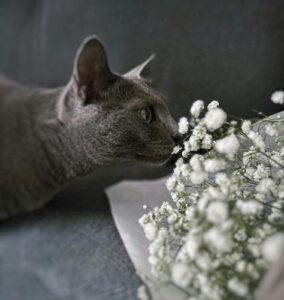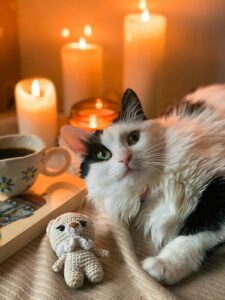𝐎𝐥𝐢𝐯𝐞𝐫’𝐬 𝐒𝐭𝐨𝐫𝐲
When a new human baby becomes part of the family, most parents know that the house must be childproofed to eliminate any possible dangers to the child’s health. As loving cat owners, we must do the same for our feline friends. The only difference is that children eventually learn about house hazards, whereas cats will need our help for as long as they live.
𝐓𝐡𝐢𝐬 𝐢𝐬 𝐭𝐡𝐞 𝐬𝐭𝐨𝐫𝐲 𝐨𝐟 𝐎𝐥𝐢𝐯𝐞𝐫, 𝐭𝐡𝐞 𝐠𝐢𝐧𝐠𝐞𝐫 𝐭𝐚𝐛𝐛𝐲, 𝐰𝐡𝐨 𝐜𝐚𝐦𝐞 𝐰𝐢𝐭𝐡𝐢𝐧 𝐚𝐧 𝐢𝐧𝐜𝐡 𝐨𝐟 𝐡𝐢𝐬 𝐥𝐢𝐟𝐞 𝐛𝐞𝐜𝐚𝐮𝐬𝐞 𝐨𝐟 𝐚 𝐬𝐢𝐦𝐩𝐥𝐞 𝐚𝐢𝐫 𝐟𝐫𝐞𝐬𝐡𝐞𝐧𝐞𝐫:
 Oliver was a healthy, four-year-old indoor cat when this happened. One day, his owner noticed that Oliver had a runny nose. He wasn’t sneezing or coughing, but she still took him to the vet. After examining him at the clinic, the vet believed Oliver had an Upper Respiratory Infection (URI) and sent him home with medicine that should clear up the infection within a week. Oliver was a good boy and ate his pills, but the infection didn’t clear up. Instead, the discharge from his nose became thicker, more frequent, and eventually bloody. His owner kept a close eye on him, and when she noticed the blood in the mucus, she immediately rushed Oliver back to the vet. This was on a Sunday, so they had to go to emergency care. Here, the vet took samples of Oliver’s mucus for analysis, sent him home with more antibiotics and an antibiotic wash to use for cleaning his nose. The plan was to wait for the lab results and decide what to do then. That same evening, however, Oliver rapidly began to decline. He refused to eat or drink, became lethargic, and withdrew from his humans completely – something very much out of character for the sociable Oliver.
Oliver was a healthy, four-year-old indoor cat when this happened. One day, his owner noticed that Oliver had a runny nose. He wasn’t sneezing or coughing, but she still took him to the vet. After examining him at the clinic, the vet believed Oliver had an Upper Respiratory Infection (URI) and sent him home with medicine that should clear up the infection within a week. Oliver was a good boy and ate his pills, but the infection didn’t clear up. Instead, the discharge from his nose became thicker, more frequent, and eventually bloody. His owner kept a close eye on him, and when she noticed the blood in the mucus, she immediately rushed Oliver back to the vet. This was on a Sunday, so they had to go to emergency care. Here, the vet took samples of Oliver’s mucus for analysis, sent him home with more antibiotics and an antibiotic wash to use for cleaning his nose. The plan was to wait for the lab results and decide what to do then. That same evening, however, Oliver rapidly began to decline. He refused to eat or drink, became lethargic, and withdrew from his humans completely – something very much out of character for the sociable Oliver.
I had helped Oliver overcome an aversion to his litter box the previous year, so, not knowing what else to do, Oliver’s owner called me. As a cat behaviorist, my work focuses on the cat’s environment, so on the phone, we began a systematic examination of any possible changes to Oliver’s home. We went through everything. Had she done any renovations to the house? Had she been spring cleaning? Had she had any pest problems? Could Oliver have ingested paint, rat poison, detergent, glue, or any other cleaning agents? The answer to all these questions was no. In fact, the owner was very diligent about keeping any such substances far away from Oliver. They didn’t even come into the house but were locked away in a shed behind the garage, so we were almost out of options. But then, Oliver’s owner suddenly remembered that her friend had given her a couple of air fresheners three weeks earlier. They were diffusers that you plug into an outlet in the home, and here was, finally, our answer.
𝐓𝐡𝐢𝐬 𝐢𝐬 𝐰𝐡𝐲 𝐝𝐢𝐟𝐟𝐮𝐬𝐞𝐫𝐬 𝐚𝐧𝐝 𝐨𝐭𝐡𝐞𝐫 𝐜𝐡𝐞𝐦𝐢𝐜𝐚𝐥 𝐚𝐢𝐫 𝐟𝐫𝐞𝐬𝐡𝐞𝐧𝐞𝐫𝐬 (𝐢𝐧𝐜𝐥𝐮𝐝𝐢𝐧𝐠 𝐞𝐬𝐬𝐞𝐧𝐭𝐢𝐚𝐥 𝐨𝐢𝐥𝐬) 𝐚𝐫𝐞 𝐞𝐱𝐭𝐫𝐞𝐦𝐞𝐥𝐲 𝐝𝐚𝐧𝐠𝐞𝐫𝐨𝐮𝐬 𝐭𝐨 𝐜𝐚𝐭𝐬:
 Most air fresheners contain something called 𝘝𝘰𝘭𝘢𝘵𝘪𝘭𝘦 𝘖𝘳𝘨𝘢𝘯𝘪𝘤 𝘊𝘰𝘮𝘱𝘰𝘶𝘯𝘥𝘴 (VOCs). They are organic chemicals that have a high vapor pressure at room temperature, which causes VOCs to turn into gases or vapors from a solid or liquid form quite easily. This transformation is called 𝘷𝘰𝘭𝘢𝘵𝘪𝘭𝘪𝘵𝘺 and describes the chemical process that makes air fresheners work – they dissipate into the air quickly, thereby changing the scent.
Most air fresheners contain something called 𝘝𝘰𝘭𝘢𝘵𝘪𝘭𝘦 𝘖𝘳𝘨𝘢𝘯𝘪𝘤 𝘊𝘰𝘮𝘱𝘰𝘶𝘯𝘥𝘴 (VOCs). They are organic chemicals that have a high vapor pressure at room temperature, which causes VOCs to turn into gases or vapors from a solid or liquid form quite easily. This transformation is called 𝘷𝘰𝘭𝘢𝘵𝘪𝘭𝘪𝘵𝘺 and describes the chemical process that makes air fresheners work – they dissipate into the air quickly, thereby changing the scent.
Unfortunately, there is little to no difference between the volatility of an air freshener and that of paint, varnishes, fossil fuels, benzene, formaldehyde, and similar chemical products. So, having an air freshener in your home can be the same as leaving an open paint or benzene can in the middle of the room and allowing the vapors to dissipate in the air. And since most outlets are placed close to the floor, within easy reach of pets, the risk of subjecting your cat or dog to the poisonous vapors is significantly increased.
In Oliver’s case, his nose and airways had become so damaged by the vapors he was constantly inhaling that his lungs were close to failing. Notice that it didn’t take more than three weeks of exposure for this to happen. Once we suspected that the cause was the air fresheners, however, the owner was quick to act. She drove the sick Oliver to her sister’s house, where there were no air fresheners, and where he could stay in a quiet room until he felt better. Once out of his toxic environment, Oliver made a full recovery and is now a happy, six-year-old kitty, living at home again. Needless to say, his owner is done with air fresheners for good.
 As a final note, I want to point out that toxic poisoning affecting a cat’s airways can be extremely difficult to diagnose. The pet presents with the same symptoms as with an Upper Respiratory Infection, so thinking it is an URI is most plausible. It is only after URIs have been ruled out that most vets will think of poisoning. For that reason, we as cat owners must always remember that any chemicals, we add to our pet’s environment can be extremely dangerous.
As a final note, I want to point out that toxic poisoning affecting a cat’s airways can be extremely difficult to diagnose. The pet presents with the same symptoms as with an Upper Respiratory Infection, so thinking it is an URI is most plausible. It is only after URIs have been ruled out that most vets will think of poisoning. For that reason, we as cat owners must always remember that any chemicals, we add to our pet’s environment can be extremely dangerous.
My advice is to avoid air fresheners altogether, and I include scented candles, dryer sheets, cat litter deodorizer, and essential oils in this category. Producers of essential oils, in particular, tend to market them as “natural”, but this is often misleading. It only means that the oils in question also consist of organic compounds, not that these compounds are healthy. The organic compounds in essential oils can be just as volatile as those of other VOCs.
Oliver’s story ended happily, but not all pet cats are that lucky. Please don’t risk your cat’s life for the sake of a perfume product.
None of the photos used in this article are of Oliver, but his story is posted with the permission of Oliver’s owner, Maggie Hayes.



